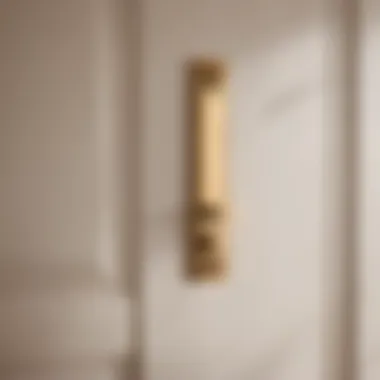Mastering the Art of Painting a Bedroom Door: Step-by-Step Guide


Materials:
- 1 gallon of high-quality paint (choose a color that suits your bedroom decor)
- Paintbrushes (2-3 inch angled brush and small trim brush)
- Painter's tape
- Drop cloths or plastic sheets to protect the floor
- Sandpaper (medium grit)
- Tack cloth or damp cloth for cleaning surfaces
- Paint tray and liners
- Paint stir sticks
- Paint roller and roller cover
DIY Steps:
- Preparation: Start by removing the door from its hinges and laying it flat on sawhorses covered with a drop cloth. Clean the door surface with a damp cloth and sand any existing paint for better adhesion.
- Taping and Protecting: Use painter's tape to protect hinges, doorknobs, and areas you don't want to paint. Cover surrounding floor and walls with drop cloths or plastic sheets.
- Priming: Prime the door with a high-quality primer suitable for the type of paint you'll be using. This step ensures better paint adhesion and uniform color.
- Paint Application: Stir the paint thoroughly and pour it into the paint tray. Use the angled brush for edges and corners and the roller for flat surfaces. Apply thin, even coats, allowing each coat to dry before adding another.
- Drying and Rehanging: Allow the door to dry completely between coats as per the paint instructions. Once dry, reattach the door to the frame.
Technical Aspects:
- Timing is crucial; follow paint manufacturer's instructions for drying times between coats.
- Use a high-quality synthetic brush for a smoother finish.
- Ensure proper ventilation when painting to avoid inhaling fumes.
- Opt for a semi-gloss or satin finish for durability and easy cleaning.
DIY Project Process:
Begin with meticulous preparation by cleaning and sanding the door surface. Proper taping and protecting surrounding areas are essential to avoid accidental spills or splatters. Priming sets the foundation for a flawless paint finish. Paint application requires attention to detail with the right tools for a professional outcome. Allow adequate drying time between coats for a lasting finish. Troubleshooting tip: If paint drips or pools, gently sand the area once dry and reapply a thin coat for seamless results.
Introduction
Understanding the Importance of a Well-Painted Bedroom Door
A well-painted bedroom door is not merely a functional element; it is a design statement. Understanding the importance of a well-painted bedroom door lies in recognizing its role as a visual anchor in the room. It sets the tone for the room's decor, tying together different design elements and colors. A beautifully painted door can create a seamless flow in the room, enhancing its overall atmosphere and making a lasting impression on anyone who enters.
Benefits of Painting Your Bedroom Door
Painting your bedroom door offers a myriad of benefits beyond just adding a splash of color. Firstly, it allows you to personalize your space and infuse it with your unique style. Whether you opt for a bold hue to make a statement or a soft pastel for a calming effect, painting your bedroom door gives you the freedom to tailor your room to your taste. Additionally, a freshly painted door can brighten up the room, making it feel more spacious and inviting. Moreover, painting your bedroom door provides a budget-friendly way to update the room's look without committing to a complete renovation. Overall, the benefits of painting your bedroom door extend far beyond aesthetics, contributing to a cozy and welcoming living environment.
Preparation Stage
In the realm of painting, the preparation stage stands as the foundational pillar for achieving a flawless finish when painting a bedroom door. This crucial phase sets the tone for the entire painting process, ensuring that all subsequent steps unfold smoothly and result in a professional-looking outcome. Attention to detail during the preparation stage can make a significant difference in the final appearance of the painted door.
Gathering the Necessary Tools and Materials


When embarking on the journey of painting a bedroom door, the first step is to gather all the essential tools and materials required for the task. Each item plays a specific role in ensuring that the painting process progresses efficiently and delivers satisfying results. From sandpaper to painter's tape, primer, paintbrushes, paint tray, and the paint of choice, each element has a vital function in achieving a successful painting project.
Sandpaper
Sandpaper holds a pivotal role in preparing the surface of the door for painting. It aids in smoothing rough areas, removing old paint or varnish, and creating a perfect canvas for the new coat of paint. The key characteristic of sandpaper lies in its abrasive texture, which allows for effective sanding of surfaces to promote better paint adhesion. Its unique feature lies in the various grit options available, each suitable for different surface types and levels of preparation. Using the right sandpaper grit ensures a uniform surface ready for painting, promoting a professional finish for the bedroom door.
Painter's Tape
Painter's tape is an indispensable tool that assists in achieving clean and defined paint lines. Its primary purpose is to protect areas of the door that should not be painted, such as trims, handles, or adjacent walls. The key characteristic of painter's tape is its ability to adhere firmly to surfaces without causing damage or leaving behind residue. This feature makes it a popular choice in painting projects, ensuring neat and professional results. Painter's tape's unique feature is its flexibility, allowing for precise masking of areas that require protection during the painting process.
Primer
Primer acts as a foundation for the paint, providing a smooth and uniform base for better paint adhesion and durability. Its key characteristic lies in its ability to seal porous surfaces, hide imperfections, and enhance the color and finish of the final coat of paint. Choosing the right primer is essential for ensuring the longevity and quality of the painted door. The unique feature of primer is its specific formulations designed for various surfaces, such as wood, metal, or laminate, offering tailored solutions for optimal painting results.
Paintbrushes
Paintbrushes are essential tools that facilitate the application of paint with precision and control. The key characteristic of paintbrushes is their bristle material, shape, and size, which influence the type of finish and coverage achieved. Selecting the appropriate paintbrush ensures even application and professional results. The unique feature of paintbrushes lies in the wide array of options available, including angled brushes for corners, flat brushes for large surfaces, and fine brushes for intricate details, catering to various painting needs.
Paint Tray
The paint tray serves as a practical tool for holding and distributing paint during the painting process. Its key characteristic is the shallow well that allows for easy loading of paint and even distribution on the roller or brush. The paint tray's design prevents spills and drips, promoting a tidy working environment and efficient paint application. The unique feature of a paint tray is its disposable nature, making cleanup hassle-free and simplifying the painting process.
Paint of Choice
Selecting the right paint for the bedroom door is a key decision that influences the overall appearance and durability of the painted surface. The key characteristic of the paint of choice is its formulation, which includes properties like coverage, finish, and drying time. Factors such as color selection, sheen level, and paint type (latex, oil-based, etc.) should be considered when choosing the paint for the door. The unique feature of paint lies in the vast range of colors and finishes available, allowing for creative expression and customization to suit individual preferences and interior decor themes.
Painting Process
In the realm of painting a bedroom door, the painting process stands as the pivotal stage where the transformation from a mundane door to a captivating focal point takes place. It is here that meticulous attention to detail and precision are required to achieve a flawless finish that enhances the aesthetics of the entire room. The painting process is not merely about applying color but a careful orchestration of steps that involve priming, selecting the right paint, and mastering precise application techniques.
Applying Primer
When it comes to painting a bedroom door, applying primer is a critical step that sets the foundation for a professional-looking finish. Primer acts as a base coat that enhances paint adhesion, smoothens out the surface imperfections, and ensures color consistency. By creating a uniform surface for the paint to adhere to, primer helps in achieving a more durable and long-lasting result. It also prevents the underlying surface from absorbing too much paint, leading to a more even application.


Choosing the Right Paint
Selecting the Paint Finish
The choice of paint finish plays a significant role in the overall look and feel of the painted bedroom door. Whether opting for a matte, eggshell, satin, semi-gloss, or high-gloss finish, each type offers distinct characteristics that impact the aesthetics and functionality of the door. For instance, a matte finish provides a subtle, elegant appearance ideal for creating a sophisticated ambiance, while a high-gloss finish adds drama and reflects light, making the door a standout feature in the room. Considering factors such as ease of cleaning, durability, and desired visual effect is crucial when selecting the paint finish for a bedroom door.
Considering Color Options
The color choice for painting a bedroom door is a personal decision that can significantly influence the room's overall atmosphere. From soothing pastels to bold hues, the color options are vast and allow for creative expression and coordination with the existing decor. Warm tones such as beige or taupe impart a cozy, inviting feel, while cool colors like blue or gray evoke a sense of tranquility and sophistication. Factors such as natural light levels, room size, and intended mood should be taken into account when deciding on the color scheme for the bedroom door.
Paint Application Techniques
Using Even Strokes
Achieving a smooth and professional finish on a bedroom door involves using even strokes during the painting process. Consistent strokes and controlled movements ensure that the paint coverage is uniform, minimizing visible brush marks and streaks. By maintaining a steady hand and applying the paint in one direction, a seamless finish can be achieved that enhances the overall aesthetics of the door.
Applying Multiple Coats
Applying multiple coats of paint is essential for achieving full coverage and a rich, saturated color on the bedroom door. Each coat builds upon the previous one, filling in any missed spots and creating a solid, opaque finish. Allow sufficient drying time between coats to prevent drips, streaks, or uneven drying. The number of coats required may vary based on the paint color, type, and desired intensity of the final shade.
Avoiding Drips
One common challenge faced during the painting process is the occurrence of drips, which can mar the smooth finish of the door. To avoid drips, it is crucial to load the brush or roller with an appropriate amount of paint, ensuring excess drips off before application. Additionally, working in small sections, using a light touch, and maintaining a consistent paint thickness can help prevent drips and achieve a professional look. Careful attention to detail and vigilance against drips can elevate the overall quality of the painted bedroom door.
Finishing Touches
In the grand scheme of painting a bedroom door, the finishing touches play a pivotal role in bringing the entire project together seamlessly. These final steps are crucial in ensuring a professional and polished outcome that elevates the aesthetics of the door and the room as a whole. From removing painter's tape to allowing for appropriate drying and curing time, each aspect contributes to the longevity and visual appeal of the freshly painted door.
Removing Painter's Tape
The meticulous task of removing painter's tape marks a significant milestone in the painting process. When executed with precision and care, this step can make or break the clean lines and neat edges of your painted door. Peeling off the painter's tape at the right angle and pace is essential to prevent any accidental damage to the fresh paint layers. Taking your time during this process is crucial to retain the crisp borders and defined sections of color, ensuring a professional finish.
Allowing for Drying and Curing Time


One of the most underestimated yet critical aspects of painting a door is allowing ample time for drying and curing. Rushing through this phase can compromise the entire project, leading to smudges, smears, or imperfections in the finish. Patience is key when it comes to drying and curing, as each coat of paint needs sufficient time to set and harden properly. Factors such as humidity and temperature can influence the drying process, so it is imperative to follow the manufacturer's instructions regarding drying times between coats to achieve a durable and flawless result.
Reattaching the Door Hardware
After the paint has dried and cured to perfection, the final step in the painting process involves reattaching the door hardware. This seemingly straightforward task can add the finishing flourish to your door makeover, seamlessly blending functionality with aesthetics. Carefully reinstalling the hinges, doorknobs, and any other hardware ensures that your door not only looks visually appealing but also functions smoothly. Taking the time to align and secure the hardware properly guarantees that your painted door retains its newfound beauty for years to come.
Maintenance Tips
When it comes to maintaining the freshly painted look of your bedroom door, following proper maintenance tips is essential in preserving the beauty and longevity of the paint job. Neglecting maintenance can lead to premature wear and a dull appearance, detracting from the overall aesthetic of your living space. By implementing a few simple tasks regularly, you can ensure that your painted door remains vibrant and pristine.
One of the key maintenance tips involves regular cleaning to remove dust, dirt, and grime that can accumulate on the surface of the door over time. Using a mild soap solution and a soft cloth, gently wipe down the door to keep it free from debris. Avoid harsh chemicals that can damage the paint finish and opt for gentle cleaning methods to maintain the door's sheen.
Additionally, periodic inspections are crucial to spot any signs of wear or damage early on. By checking for chipped paint, scratches, or any other imperfections, you can address them promptly before they worsen. Touching up small areas of damage with a matching paint color can prevent them from becoming more visible and extend the lifespan of your door's finish.
Furthermore, protecting the door from excess moisture, direct sunlight, and heavy impacts can help maintain its appearance for years to come. Using door mats to trap dirt, closing windows during rainy weather, and avoiding slamming the door can minimize wear and tear on the paint. These preventive measures can go a long way in preserving the beauty of your freshly painted bedroom door.
Cleaning and Caring for Your Painted Door
Cleaning and caring for your painted door is a fundamental part of maintaining its appearance and extending its lifespan. Regular cleaning not only keeps the door looking fresh and vibrant but also prevents dirt and grime from causing long-term damage.
To start, prepare a gentle cleaning solution using mild soap or detergent and water. Avoid harsh chemicals that can strip the paint and opt for a soft sponge or cloth to scrub the surface gently. Wipe the door in a circular motion to ensure thorough cleaning without scratching the paint.
It is important to pay attention to the door handles, as they are common areas for dirt and oils to accumulate. Use a separate cloth dipped in the cleaning solution to wipe down the handles and hinges, ensuring they remain clean and free from buildup.
After cleaning, rinse the door with a clean damp cloth to remove any soap residue, followed by a dry cloth to prevent water spots. Avoid using excess water, which can penetrate the wood and potentially damage the paint. Let the door air dry completely before closing it to prevent moisture accumulation.
Regular maintenance such as dusting and occasional deep cleaning can help preserve the appearance of your painted door. By practicing proper cleaning techniques and investing time in caring for your door, you can enjoy a beautiful and well-maintained finish for years to come.
Touching Up Any Imperfections
Even with regular maintenance, minor imperfections may arise on your painted door over time. Whether due to everyday wear and tear or accidental damage, touching up these imperfections is a simple yet effective way to maintain the door's pristine appearance.
To begin, assess the extent of the imperfections, such as chipped paint, scratches, or scuffs. Purchase a small container of matching paint from your original paint selection to ensure a seamless touch-up. Use a fine paintbrush to carefully fill in the damaged areas, applying a thin coat of paint to blend it with the surrounding surface.
After the paint has dried, assess the results to determine if additional touch-ups are needed. For larger imperfections, consider sanding the area lightly before repainting to achieve a smoother finish. Take care to feather the edges of the new paint with the existing paint to avoid visible lines or build-up.
Once the touch-up paint has dried completely, inspect the door from various angles to ensure a consistent appearance. Buffing the area gently with a soft cloth can help blend the touch-up paint seamlessly with the rest of the door, creating a uniform finish.
By addressing imperfections promptly and employing careful touch-up techniques, you can maintain the pristine look of your painted door and ensure it remains a stylish focal point in your living space.







